Abstract
Hairy cell leukemia (HCL) is a rare chronic B-cell malignancy that, according to modern classifications, is a subgroup of non-Hodgkin lymphomas (NHLs). A rapid increase in incidence of NHL has been reported in many countries. The reasons for this increase are largely unknown, but exposure to organochlorines has been suggested as a risk factor. Epstein-Barr virus is a human herpesvirus that has been associated with certain subgroups of NHL. In this study, we measured lipid adjusted blood concentrations (in nanogram per gram) of 36 congeners of polychlorinated biphenyls (PCBs), p, p'-dichlorodiphenyldichloroethylene (p,p'-DDE), hexachlorobenzene (HCB), and four subgroups of chlordanes (trans-nonachlor, cis-nonachlor, MC6, and oxychlordane) in incident cases of HCL and controls from the general population. We obtained results on organochlorines and antibodies for 54 cases and 54 controls. Titers of antibodies to the Epstein-Barr early antigen and Epstein-Barr nuclear antigen, measured as P107, were correlated to concentrations of organochlorines to evaluate the possibility of an interaction between these factors in the pathogenesis of HCL. We found no significant difference in lipid-adjusted blood concentrations of total PCBs, p,p'-DDE, HCB, or the sum of the chlordanes between cases and controls. Titers of antibodies to Epstein-Barr early antigen IgG [Greater and equal to] 40 were correlated to an increased risk for HCL. This risk was further increased in those with a level above the median value of p,p'-DDE, HCB, or the sum of the chlordanes, suggesting an interaction between Epstein-Barr virus and a higher concentration of these chemicals. We also found increased risk for the sum of immunotoxic PCB group.
Full text
PDF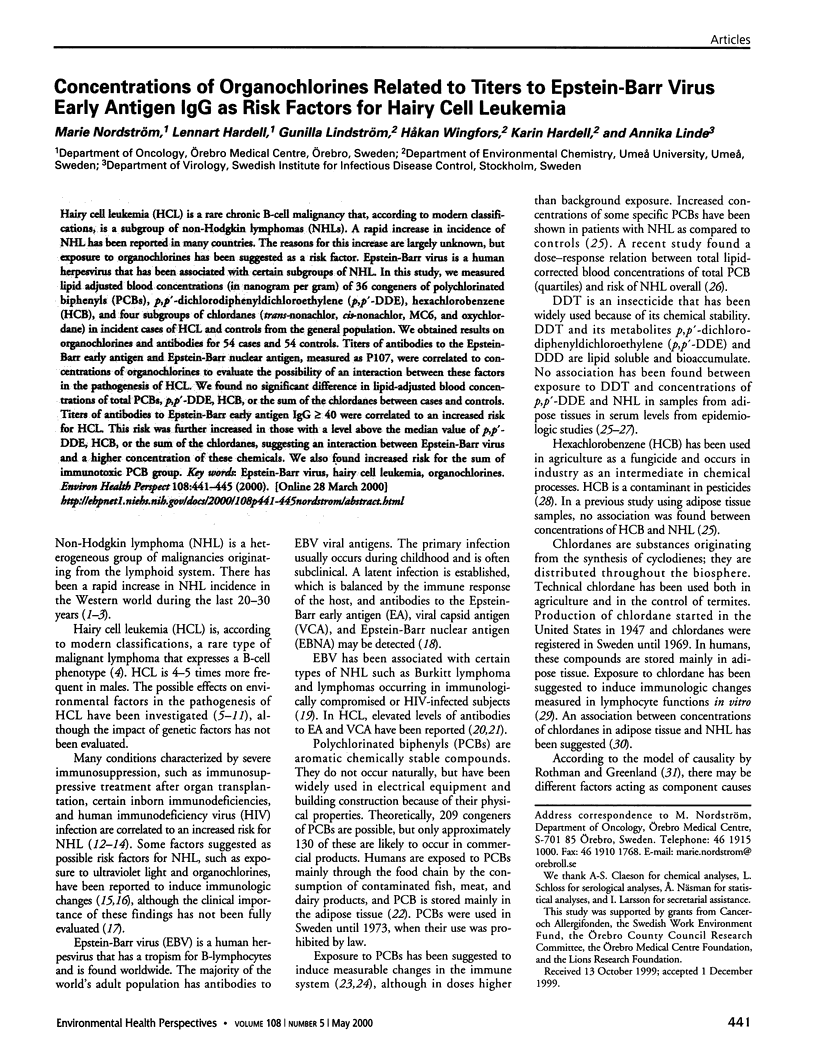
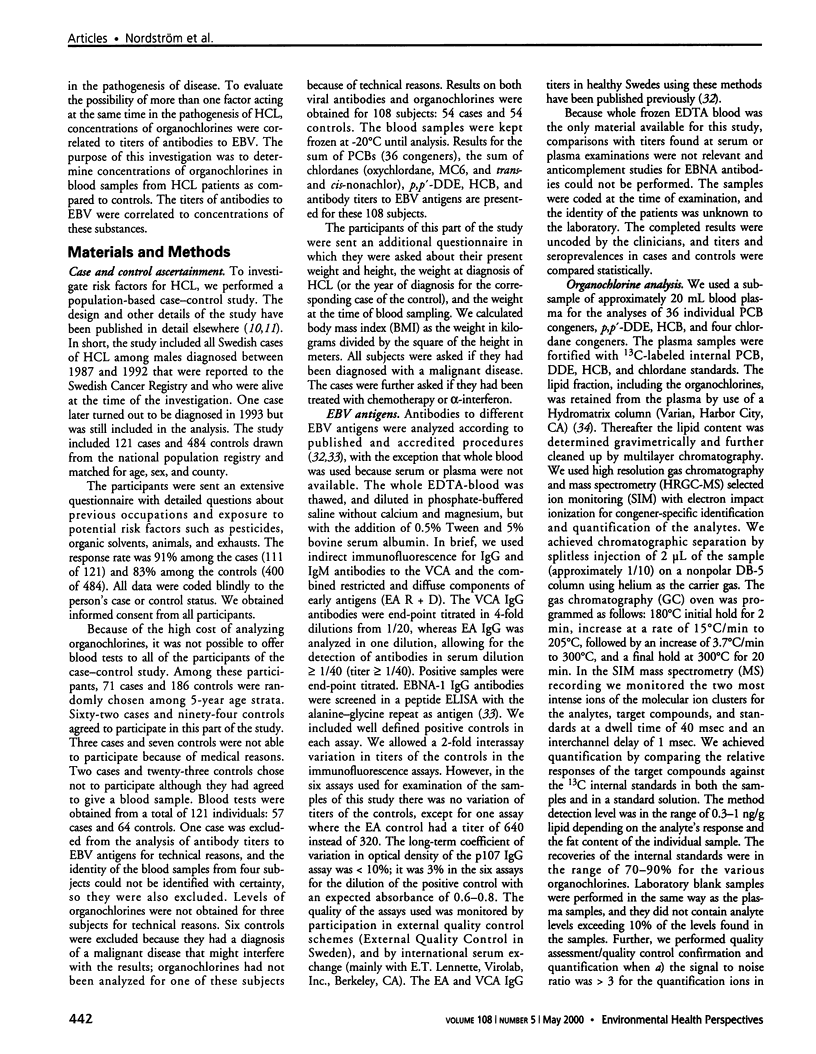
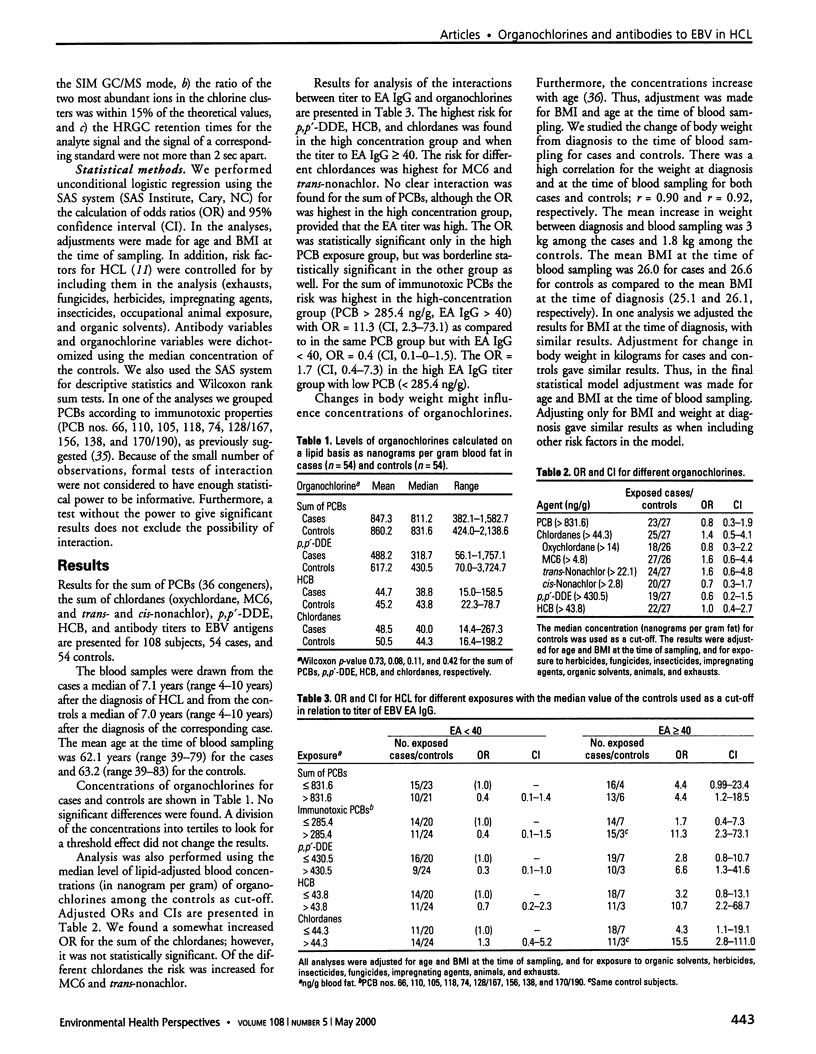
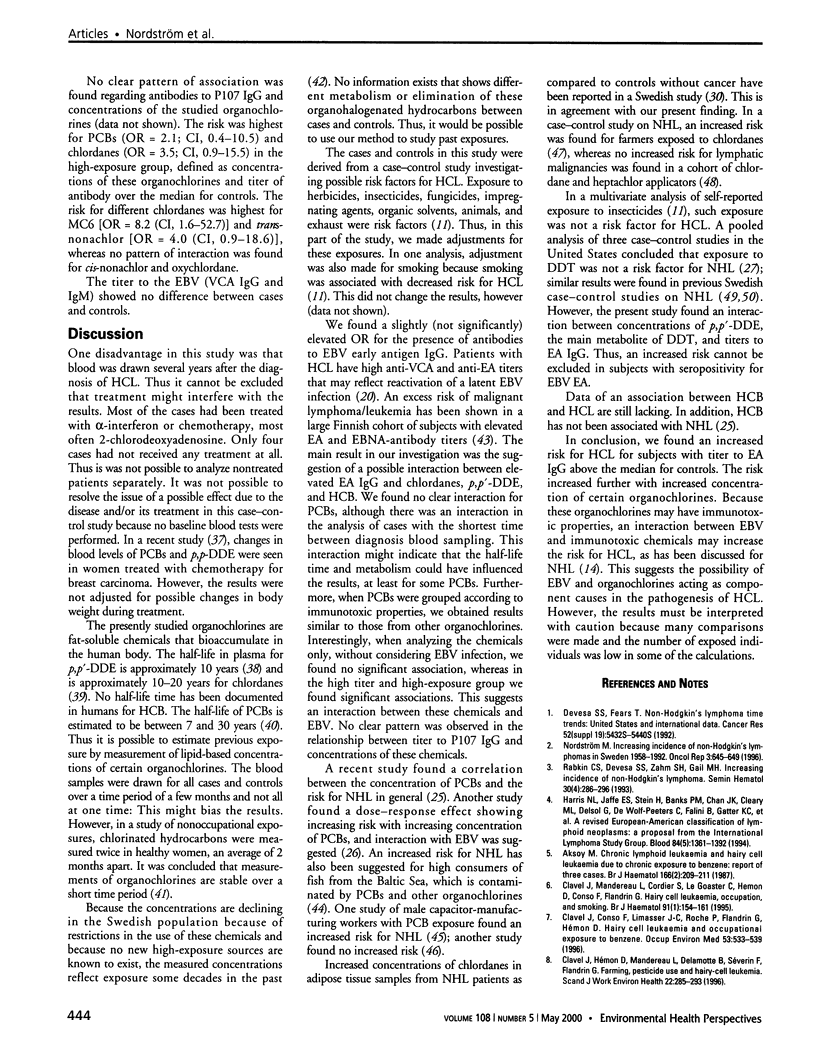
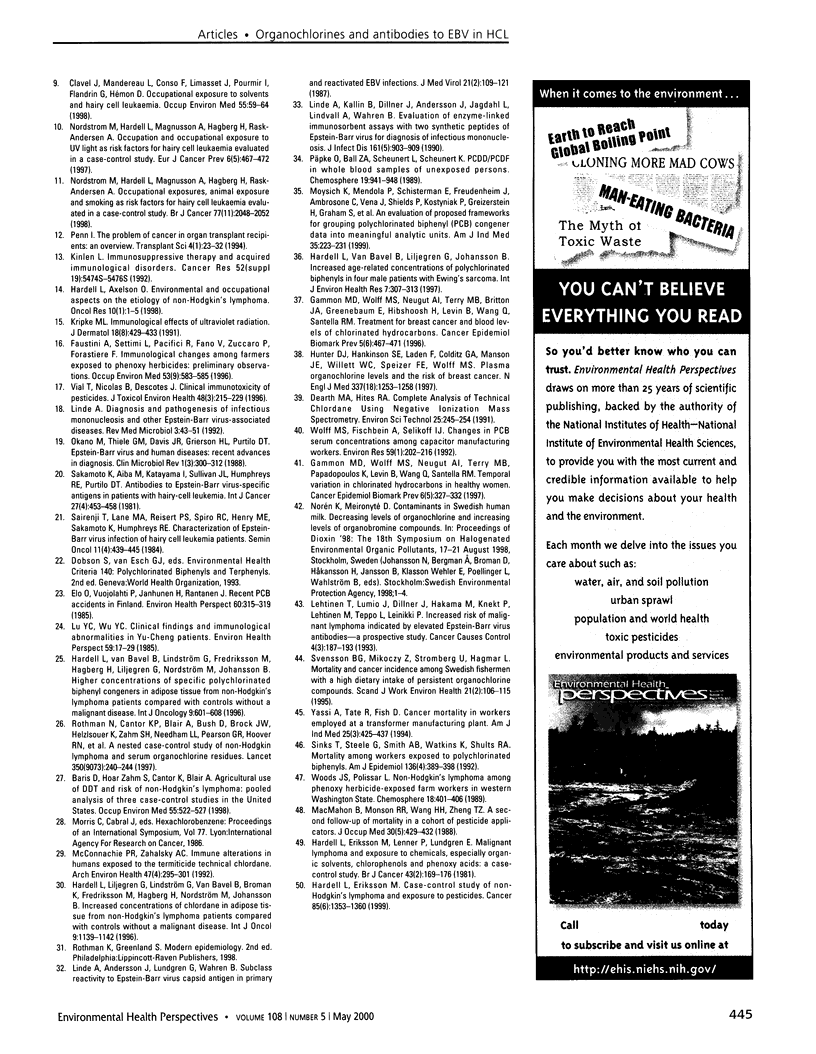
Selected References
These references are in PubMed. This may not be the complete list of references from this article.
- Aksoy M. Chronic lymphoid leukaemia and hairy cell leukaemia due to chronic exposure to benzene: report of three cases. Br J Haematol. 1987 Jun;66(2):209–211. doi: 10.1111/j.1365-2141.1987.tb01300.x. [DOI] [PubMed] [Google Scholar]
- Baris D., Zahm S. H., Cantor K. P., Blair A. Agricultural use of DDT and risk of non-Hodgkin's lymphoma: pooled analysis of three case-control studies in the United States. Occup Environ Med. 1998 Aug;55(8):522–527. doi: 10.1136/oem.55.8.522. [DOI] [PMC free article] [PubMed] [Google Scholar]
- Clavel J., Conso F., Limasset J. C., Mandereau L., Roche P., Flandrin G., Hémon D. Hairy cell leukaemia and occupational exposure to benzene. Occup Environ Med. 1996 Aug;53(8):533–539. doi: 10.1136/oem.53.8.533. [DOI] [PMC free article] [PubMed] [Google Scholar]
- Clavel J., Hémon D., Mandereau L., Delemotte B., Séverin F., Flandrin G. Farming, pesticide use and hairy-cell leukemia. Scand J Work Environ Health. 1996 Aug;22(4):285–293. doi: 10.5271/sjweh.143. [DOI] [PubMed] [Google Scholar]
- Clavel J., Mandereau L., Conso F., Limasset J. C., Pourmir I., Flandrin G., Hémon D. Occupational exposure to solvents and hairy cell leukaemia. Occup Environ Med. 1998 Jan;55(1):59–64. doi: 10.1136/oem.55.1.59. [DOI] [PMC free article] [PubMed] [Google Scholar]
- Clavel J., Mandereau L., Cordier S., Le Goaster C., Hémon D., Conso F., Flandrin G. Hairy cell leukaemia, occupation, and smoking. Br J Haematol. 1995 Sep;91(1):154–161. doi: 10.1111/j.1365-2141.1995.tb05261.x. [DOI] [PubMed] [Google Scholar]
- Devesa S. S., Fears T. Non-Hodgkin's lymphoma time trends: United States and international data. Cancer Res. 1992 Oct 1;52(19 Suppl):5432s–5440s. [PubMed] [Google Scholar]
- Elo O., Vuojolahti P., Janhunen H., Rantanen J. Recent PCB accidents in Finland. Environ Health Perspect. 1985 May;60:315–319. doi: 10.1289/ehp.8560315. [DOI] [PMC free article] [PubMed] [Google Scholar]
- Faustini A., Settimi L., Pacifici R., Fano V., Zuccaro P., Forastiere F. Immunological changes among farmers exposed to phenoxy herbicides: preliminary observations. Occup Environ Med. 1996 Sep;53(9):583–585. doi: 10.1136/oem.53.9.583. [DOI] [PMC free article] [PubMed] [Google Scholar]
- Gammon M. D., Wolff M. S., Neugut A. I., Terry M. B., Britton J. A., Greenebaum E., Hibshoosh H., Levin B., Wang Q., Santella R. M. Treatment for breast cancer and blood levels of chlorinated hydrocarbons. Cancer Epidemiol Biomarkers Prev. 1996 Jun;5(6):467–471. [PubMed] [Google Scholar]
- Gammon M. D., Wolff M. S., Neugut A. I., Terry M. B., Papadopoulos K., Levin B., Wang Q., Santella R. M. Temporal variation in chlorinated hydrocarbons in healthy women. Cancer Epidemiol Biomarkers Prev. 1997 May;6(5):327–332. [PubMed] [Google Scholar]
- Hardell L., Axelson O. Environmental and occupational aspects on the etiology of non-Hodgkin's lymphoma. Oncol Res. 1998;10(1):1–5. [PubMed] [Google Scholar]
- Hardell L., Eriksson M. A case-control study of non-Hodgkin lymphoma and exposure to pesticides. Cancer. 1999 Mar 15;85(6):1353–1360. doi: 10.1002/(sici)1097-0142(19990315)85:6<1353::aid-cncr19>3.0.co;2-1. [DOI] [PubMed] [Google Scholar]
- Hardell L., Eriksson M., Lenner P., Lundgren E. Malignant lymphoma and exposure to chemicals, especially organic solvents, chlorophenols and phenoxy acids: a case-control study. Br J Cancer. 1981 Feb;43(2):169–176. doi: 10.1038/bjc.1981.25. [DOI] [PMC free article] [PubMed] [Google Scholar]
- Harris N. L., Jaffe E. S., Stein H., Banks P. M., Chan J. K., Cleary M. L., Delsol G., De Wolf-Peeters C., Falini B., Gatter K. C. A revised European-American classification of lymphoid neoplasms: a proposal from the International Lymphoma Study Group. Blood. 1994 Sep 1;84(5):1361–1392. [PubMed] [Google Scholar]
- Hunter D. J., Hankinson S. E., Laden F., Colditz G. A., Manson J. E., Willett W. C., Speizer F. E., Wolff M. S. Plasma organochlorine levels and the risk of breast cancer. N Engl J Med. 1997 Oct 30;337(18):1253–1258. doi: 10.1056/NEJM199710303371801. [DOI] [PubMed] [Google Scholar]
- Kinlen L. Immunosuppressive therapy and acquired immunological disorders. Cancer Res. 1992 Oct 1;52(19 Suppl):5474s–5476s. [PubMed] [Google Scholar]
- Kripke M. L. Immunological effects of ultraviolet radiation. J Dermatol. 1991 Aug;18(8):429–433. doi: 10.1111/j.1346-8138.1991.tb03111.x. [DOI] [PubMed] [Google Scholar]
- Lehtinen T., Lumio J., Dillner J., Hakama M., Knekt P., Lehtinen M., Teppo L., Leinikki P. Increased risk of malignant lymphoma indicated by elevated Epstein-Barr virus antibodies--a prospective study. Cancer Causes Control. 1993 May;4(3):187–193. doi: 10.1007/BF00051312. [DOI] [PubMed] [Google Scholar]
- Linde A., Andersson J., Lundgren G., Wahren B. Subclass reactivity to Epstein-Barr virus capsid antigen in primary and reactivated EBV infections. J Med Virol. 1987 Feb;21(2):109–121. doi: 10.1002/jmv.1890210203. [DOI] [PubMed] [Google Scholar]
- Lü Y. C., Wu Y. C. Clinical findings and immunological abnormalities in Yu-Cheng patients. Environ Health Perspect. 1985 Feb;59:17–29. doi: 10.1289/ehp.59-1568085. [DOI] [PMC free article] [PubMed] [Google Scholar]
- MacMahon B., Monson R. R., Wang H. H., Zheng T. Z. A second follow-up of mortality in a cohort of pesticide applicators. J Occup Med. 1988 May;30(5):429–432. doi: 10.1097/00043764-198805000-00010. [DOI] [PubMed] [Google Scholar]
- McConnachie P. R., Zahalsky A. C. Immune alterations in humans exposed to the termiticide technical chlordane. Arch Environ Health. 1992 Jul-Aug;47(4):295–301. doi: 10.1080/00039896.1992.9938365. [DOI] [PubMed] [Google Scholar]
- Moysich K. B., Mendola P., Schisterman E. F., Freudenheim J. L., Ambrosone C. B., Vena J. E., Shields P. G., Kostyniak P., Greizerstein H., Graham S. An evaluation of proposed frameworks for grouping polychlorinated biphenyl (PCB) congener data into meaningful analytic units. Am J Ind Med. 1999 Mar;35(3):223–231. doi: 10.1002/(sici)1097-0274(199903)35:3<223::aid-ajim2>3.0.co;2-l. [DOI] [PubMed] [Google Scholar]
- Nordström M., Hardell L., Magnuson A., Hagberg H., Rask-Andersen A. Occupational exposures, animal exposure and smoking as risk factors for hairy cell leukaemia evaluated in a case-control study. Br J Cancer. 1998 Jun;77(11):2048–2052. doi: 10.1038/bjc.1998.341. [DOI] [PMC free article] [PubMed] [Google Scholar]
- Nordström M., Hardell L., Magnusson A., Hagberg H., Rask-Andersen A. Occupation and occupational exposure to UV light as risk factors for hairy cell leukaemia evaluated in a case-control study. Eur J Cancer Prev. 1997 Oct;6(5):467–472. doi: 10.1097/00008469-199710000-00006. [DOI] [PubMed] [Google Scholar]
- Okano M., Thiele G. M., Davis J. R., Grierson H. L., Purtilo D. T. Epstein-Barr virus and human diseases: recent advances in diagnosis. Clin Microbiol Rev. 1988 Jul;1(3):300–312. doi: 10.1128/cmr.1.3.300. [DOI] [PMC free article] [PubMed] [Google Scholar]
- Penn I. The problem of cancer in organ transplant recipients: an overview. Transplant Sci. 1994 Sep;4(1):23–32. [PubMed] [Google Scholar]
- Rabkin C. S., Devesa S. S., Zahm S. H., Gail M. H. Increasing incidence of non-Hodgkin's lymphoma. Semin Hematol. 1993 Oct;30(4):286–296. [PubMed] [Google Scholar]
- Rothman N., Cantor K. P., Blair A., Bush D., Brock J. W., Helzlsouer K., Zahm S. H., Needham L. L., Pearson G. R., Hoover R. N. A nested case-control study of non-Hodgkin lymphoma and serum organochlorine residues. Lancet. 1997 Jul 26;350(9073):240–244. doi: 10.1016/S0140-6736(97)02088-6. [DOI] [PubMed] [Google Scholar]
- Sairenji T., Lane M. A., Reisert P. S., Spiro R. C., Henry M. E., Sakamoto K., Humphreys R. E. Characterization of Epstein-Barr virus infection of hairy cell leukemia patients. Semin Oncol. 1984 Dec;11(4):439–445. [PubMed] [Google Scholar]
- Sakamoto K., Aiba M., Katayama I., Sullivan J. L., Humphreys R. E., Purtilo D. T. Antibodies to Epstein-Barr virus-specific antigens in patients with hairy-cell leukemia. Int J Cancer. 1981;27(4):453–458. doi: 10.1002/ijc.2910270406. [DOI] [PubMed] [Google Scholar]
- Sinks T., Steele G., Smith A. B., Watkins K., Shults R. A. Mortality among workers exposed to polychlorinated biphenyls. Am J Epidemiol. 1992 Aug 15;136(4):389–398. doi: 10.1093/oxfordjournals.aje.a116511. [DOI] [PubMed] [Google Scholar]
- Svensson B. G., Mikoczy Z., Strömberg U., Hagmar L. Mortality and cancer incidence among Swedish fishermen with a high dietary intake of persistent organochlorine compounds. Scand J Work Environ Health. 1995 Apr;21(2):106–115. doi: 10.5271/sjweh.17. [DOI] [PubMed] [Google Scholar]
- Vial T., Nicolas B., Descotes J. Clinical immunotoxicity of pesticides. J Toxicol Environ Health. 1996 Jun 28;48(3):215–229. doi: 10.1080/009841096161294. [DOI] [PubMed] [Google Scholar]
- Wolff M. S., Fischbein A., Selikoff I. J. Changes in PCB serum concentrations among capacitor manufacturing workers. Environ Res. 1992 Oct;59(1):202–216. doi: 10.1016/s0013-9351(05)80240-3. [DOI] [PubMed] [Google Scholar]
- Yassi A., Tate R., Fish D. Cancer mortality in workers employed at a transformer manufacturing plant. Am J Ind Med. 1994 Mar;25(3):425–437. doi: 10.1002/ajim.4700250310. [DOI] [PubMed] [Google Scholar]


